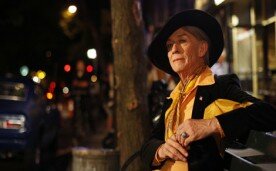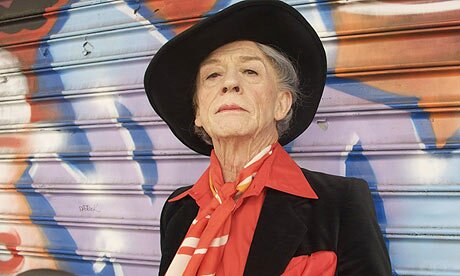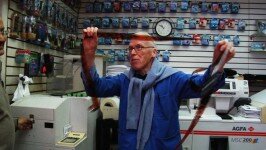Right off the bat, I admit to having literally no prior knowledge of Quentin Crisp before turning up for my first screening of this year’s Melbourne International Film Festival. In fact, it failed to register that it was a film based on the life of a real person when I had read the blurb in the MIFF programme, failed to register as I thought, “Ooh! This sounds intriguing! Book les tix!”
Upon having now seen An Englishman in New York however, I am compelled to purchase and devour Crisp’s memoirs, and find every one of his filmic performances. This is almost entirely due to the stellar, magnetic, light-up-the-screen performance of British legend John Hurt as Crisp, a role he actually first played way back when in 1975. But more about that shortly…

|
For those of you too lazy to hit up Wikipedia, Quentin Crisp was born Denis Charles Pratt in 1908 in England. Effeminate from early life, he would dye his long hair various colours, paint his nails, wear make up and experiment with women’s clothing. Denied entry into the armed forces (‘sexual perversion’ given as the reason), he modeled in life classes for artists, and published multiple books. It was upon the release of his autobiography Naked Civil Servant however, that his “career” began to take off. Chronicling his early life, it told of the angry responses and homophobic attacks he would receive because of his appearance and refusal to stay in the closet. He was approached by documentarian Denis Mitchell to make a short film, which then resulted in a television film adaptation of Naked Civil Servant, with John Hurt in the title role, hurtling both the actor and Crisp himself into the limelight. It it as this point that director Richard Laxton and writer Brian Fillis take up the story in An Englishman in New York (and yes, the song by Sting is about Quentin Crisp) picks up the story. It spans the last few decades of Crisp’s life, beginning in the late 1970s as fame has hit in Britain and it seems like a move to New York – a city even just as exciting in real life as it is in films, according to Crisp – is the next logical step.
|
|
Not being an expert in the life of Quentin Crisp, or of gay culture in New York during the 1980s, I can’t attest as to the accuracy of An Englishman in New York. Having said that though, I felt immediately drawn to the character of Crisp. John Hurt’s portrayal of the flamboyant and endlessly quotable Englishman lights up the screen. He strides confidently through the streets of New York, head held high as if performing for the entire world. He revels in the outlandishness of the city, yet isn’t anything less than completely dignified in his colourful scarves, lipstick and ever-present wide-brimmed hat. Refusing to even attempt housework (after four years the dust can’t get any worse) and insisting on attending every film premiere and dinner party he was invited to (therefore being able to live on “peanuts and champagne”) the utter filmability of this incredible life seems almost too good to be true. Plot-wise, the film follows his rise to fame through one man shows, the backlash to his comment that “AIDs is a fad” and his subsequent refusal to ever apologise for anything he said, his friendship with young artist Patrick Angus (Jonathan Tucker), then later career as a performer with artist Penny Arcade (Sex and the City‘s Cynthia Nixon, who obviously has a blast with the role), taking the viewer right up to his death in 1999.
While Hurt’s performance is obviously the first remarkable thing one notices in this film, I believe that there is much to be said for relative newcomer Jonathan Tucker as the tormented and AIDS-stricken young artist Patrick Angus. His portrayal of the star-struck young man is heartfelt and heartbreaking, upon later consideration appearing to be the emotional core of the film. It’s during these sequences that we see a deeper side to Crisp, not just the flamboyant and unflappable man that the public knows.
While the performances of Hurt, Tucker, and Denis O’Hare as Phillip Steele, Crisp’s close friend are stellar, I have to admit that there was something lacking in An Englishman in New York for me as a film. This may have something to do with the fact that the film was originally made for television and as a result has a running time of precious few minutes over an hour. I would much rather have spent an extra forty five minutes or so with Quentin, learning more about him. With a screenplay spanning about thirty years, events are skimmed over perhaps without the fanfare and depth they should have been afforded. I can’t praise Hurt’s performance enough, but at the film’s close I still wanted to know more about this amazing, fascinating man who did so much for gay rights. I wanted to more emotional depth, I wanted to know more about Phillip Steele, more about his relationship with Penny Arcade, wanted more of an insight into New York in the 1980s.
That really, was my main problem with the film. While certainly it was fascinating, and certainly it was full of fine performances, there was just…not enough. Not enough emotional depth, not enough characterisation, not enough of an insight into a world that I instantly wanted to journey into after just a few minutes of the film’s running time. I highly recommend going to check out An Englishman in New York if you ever get the chance, to learn a little bit about a fascinating personality and extraordinary life…however, a criminally short running time limits the depths in which we as an audience are able to delve into that life.
 Follow the author Rebecca Mery on Twitter.
Follow the author Rebecca Mery on Twitter.

















